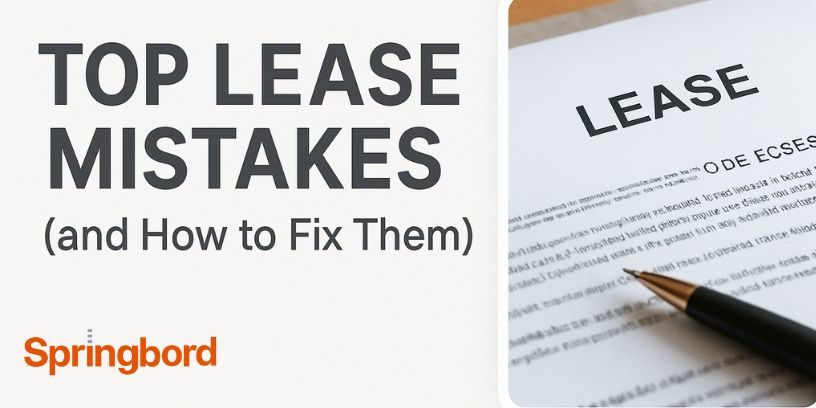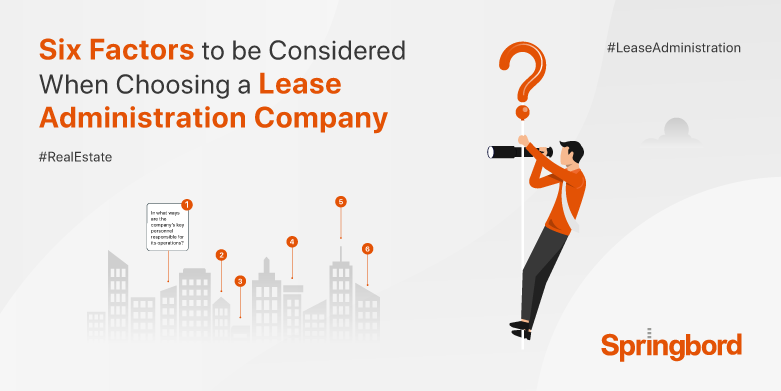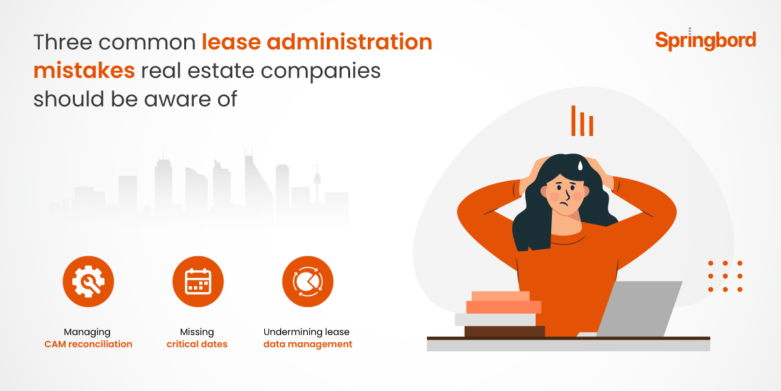 Read time 4 min
Read time 4 minIntroduction
Lease administration today plays a pivotal role in financial reporting, compliance, and portfolio strategy. Yet even with improvements in lease technology and pressure from rules like ASC 842 and IFRS 16, many companies still use scattered data, manual tracking, and old methods, putting them at risk for serious financial and compliance issues.
According to PwC, over 67% of private companies underestimated the effort required to comply with ASC 842 due to poor lease data quality and structure. CoStar reports that mismanagement of clauses like escalations and renewals routinely results in millions in avoidable costs. These recurring mistakes not only affect cash flow but also compromise audit readiness and operational planning.
From missed termination dates to inaccurate abstraction and non-standardized reporting, the risks are real and growing. This blog examines the top technical failures companies continue to make in lease administration, how they erode value, and what proactive steps can be taken to correct them.
Springbord assists businesses in overcoming these issues by organizing lease information, tracking important dates, ensuring compliance reporting, and automating processes, providing accuracy and clarity, and reducing risks in real estate holdings.
Top High-Impact Mistakes Still Costing Businesses Millions
Despite increasing regulatory scrutiny and advances in lease management technology, many organizations continue to repeat costly administrative missteps. A PwC’s ASC 842 study highlights that over 50% of private companies experienced delays and restatements due to inconsistent lease data and compliance gaps.
Each of the following issues presents a systemic risk to financial accuracy, operational efficiency, and audit readiness, and they remain prevalent across even mature real estate portfolios.
A. Decentralized or Inconsistent Lease Data
If your lease data lives in different departments, you’re already exposed to compliance risk.
When Legal, Finance, and Operations manage leases independently, data becomes fragmented and unreliable. Critical clauses, such as escalation schedules or termination rights, are often misplaced, duplicated, or misinterpreted.
This disjointed structure increases the likelihood of misreporting lease liabilities under ASC 842/IFRS 16, especially when reconciling Right-of-Use (ROU) assets or renewal options.
- Fix: Implement a unified lease data repository with standardized formats, automated alerts, and a full audit trail.
Springbord’s centralized lease management solutions help clients consolidate fragmented lease data into structured, cloud-based repositories, ensuring both accuracy and accessibility across departments.
B. Manual Processes & Spreadsheet Dependency
If your team is still using Excel to manage leases, error margins and audit gaps are inevitable.
Spreadsheets remain one of the most common tools for lease tracking, yet they’re inherently risky. Calculating CPI escalations, CAM reconciliations, and payment schedules manually results in human error, especially across large portfolios.
Delayed payments, missed escalations, and overpayments are recurring consequences, affecting both P&L and landlord relations.
- Fix: Automate rent schedules, CPI escalations, and option tracking using modern lease administration platforms.
Springbord uses its own tools and automated systems to get rid of the need for spreadsheets, making rent calculations and escalation processes easier and more accurate.
C. Missed Critical Dates (Renewals, Terminations, Options)
If you’re relying on manual reminders for renewals or terminations, you’re risking holdover penalties.
Missed renewal or termination windows can result in costly automatic renewals at unfavorable terms or even forced relocations. Lack of a centralized date tracking system is one of the most common and expensive pitfalls.
- Fix: Use a centralized calendaring system with customizable reminders for renewals, expirations, and lease options.
Springbord offers automated critical date tracking integrated with reporting dashboards, helping clients proactively manage portfolio timelines and avoid costly oversights.
D. Improper Lease Abstraction
If lease abstraction varies by property or region, your reporting is already flawed.
Inconsistent or inaccurate lease abstraction leads to a misunderstanding of key terms such as rent obligations, co-tenancy clauses, and exclusivity provisions. Without standardized abstraction methods, clause hierarchy, and terminology can vary drastically, making portfolio-wide analysis nearly impossible.
- Fix: Use standardized lease abstraction templates reviewed by real estate counsel or validated with AI tools.
Springbord focuses on providing accurate lease abstraction by using templates that match industry standards and a thorough quality check process, making sure the data is clear and useful.
E. Lack of Portfolio-Level Reporting & KPIs
If you can’t view lease obligations across your entire portfolio, you can’t manage risk at scale.
Companies often struggle to answer fundamental questions: What’s our total lease liability by region? Which leases are expiring in the next 12 months? Are we at risk due to co-tenancy failures?
Without KPI dashboards and portfolio analytics, strategic lease planning is reactive at best.
- Fix: Build dashboards to track rent rolls, expiration curves, co-tenancy clauses, and ROFO/ROFR usage.
Springbord’s customized reporting solutions provide real-time visibility into lease KPIs, empowering clients with insights for forecasting, budgeting, and strategic real estate decisions.
F. ASC 842/IFRS 16 Noncompliance
If your lease data isn’t compliance-ready, financial reporting will break down.
Compliance with ASC 842 and IFRS 16 requires precise ROU asset calculations and timely updates on lease modifications. Many companies fail to revise lease data following changes like rent concessions, term extensions, or early terminations, resulting in audit failures or restatements.
- Fix: Integrate lease systems with accounting platforms or adopt ASC 842-compliant administration tools.
Springbord ensures compliance by maintaining up-to-date lease data and generating accurate, auditor-ready outputs aligned with current accounting standards.
G. No Workflow or Governance Structure
If you make lease edits via email, you forfeit version control and your audit trail.
Without defined workflows and governance, lease changes happen without documentation or accountability. This leads to internal conflicts, missed approvals, and exposure to legal and financial discrepancies.
- Fix: Establish role-based workflows with version control, approval logs, and documentation tracking.
Springbord helps organizations implement scalable lease governance models, ensuring every lease decision is documented, authorized, and traceable.
Conclusion
Lease administration mistakes like fragmented data, missed critical dates, and manual tracking continue to cost businesses millions and expose them to compliance risks. Even with regulatory pressure from ASC 842 and IFRS 16, many organizations still lack the systems and structure needed to manage leases efficiently and accurately.
To stay competitive and compliant, companies must move beyond reactive management and adopt integrated, data-driven lease administration practices.
If your team is still battling with scattered lease data, missed deadlines, or compliance headaches, it’s time to rethink your lease administration strategy. At Springbord, we don’t just plug gaps; we help you build a scalable, compliant, and insight-driven lease management system that works across departments and portfolios.
Springbord helps you streamline lease administration with smarter data, automation, and real-time reporting. Whether you need to clean up your lease portfolio or prep for ASC 842, we’re ready to support you.
Talk to a lease expert today and take control of your lease operations before the next deadline sneaks up.







